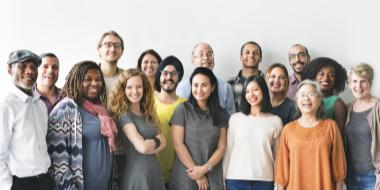Olympic Heroes with Day Jobs: Occupations of 2024 Olympians
Hours of training day in, day out, with the distant hope of a chunk of precious metal around your neck at the end of it all. We’ve all seen the dedication and sacrifice it takes to go for gold at the Olympic Games. But did you know that about one third of Olympic athletes are juggling their commitment to elite sport with the responsibility of a day job? That’s according to a data collection of athletes from four nations with the highest number of athletes competing at the 2024 Paris Olympic Games.
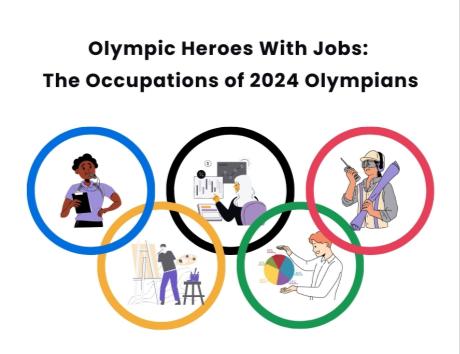
Olympic Athletes Balancing Jobs and Training
The Olympics may be the greatest show on earth, generating billions of dollars through sponsorship, media and ticket sales. But that doesn’t mean every competitor earns a fair slice of the pie. Stars such as track hero Noah Lyles, legendary gymnast Simone Biles, and superhuman pole vaulter Armand Duplantis may be set for life through sponsorships and prize money. However, the story for many other athletes involves grafting for funding and, indeed, a whole host of regular jobs.
According to Jobseeker, data from 1,807 athletes competing at the 2024 Paris Olympic Games shows a significant number of these athletes are juggling their sports commitments with day jobs. Let's explore what these jobs are, the differences between countries and what it means for the lives of these Olympians.
About One Third of Athletes Have an Additional Occupation
- 30.5% of athletes have commitments beyond their sports.
- 18.8% have day jobs, while 11.8% are students.
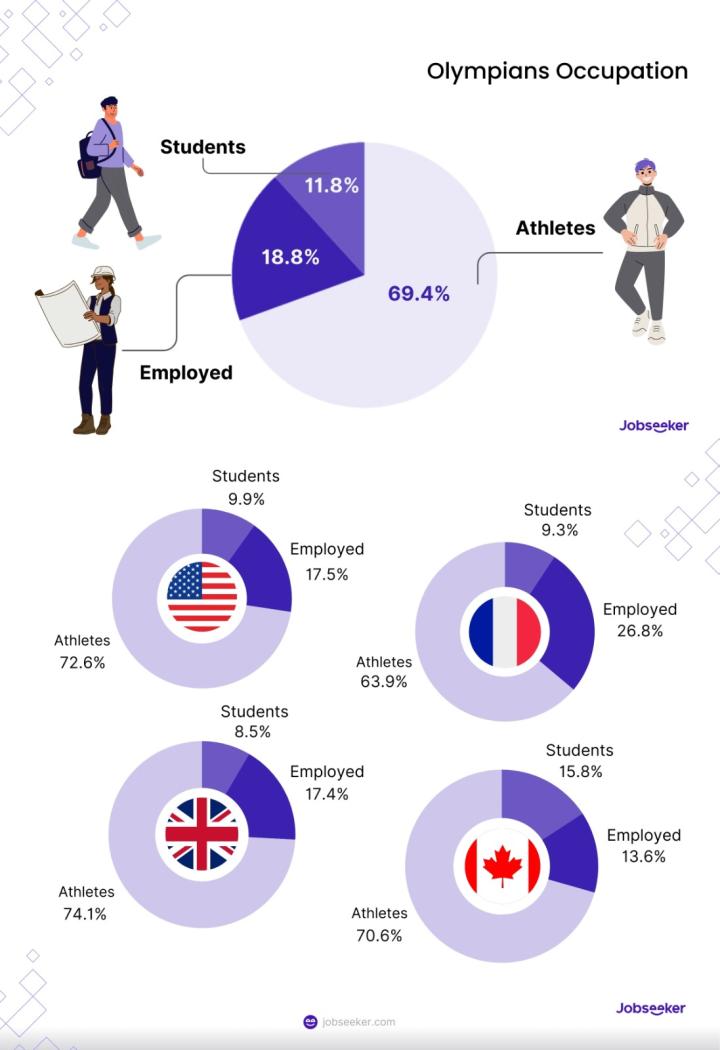
What jobs do Olympic athletes have?
So, what jobs do elite athletes do in between their demanding and time-consuming commitments to their sports? Let’s take a look at some of the key trends from the data:
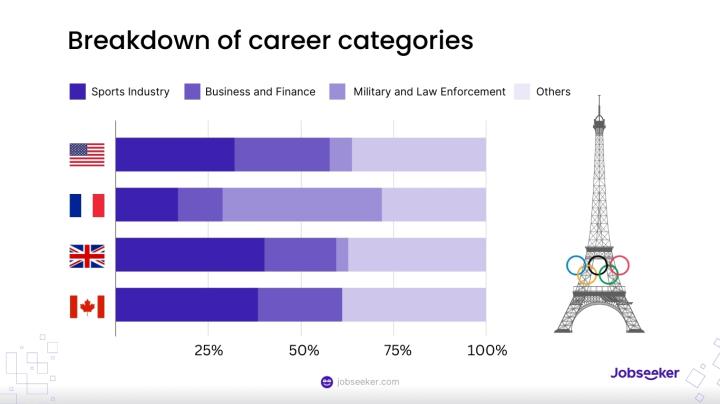
Jobs within the Sports Industry
27% of employed athletes with day jobs work in the sports industry. This suggests a commitment to their sport has opened up opportunities to make a living from their chosen specialism. There are various reasons why it makes sense for Olympic athletes to work in the sports sector:
- Continuous engagement: Working in the sports industry allows athletes to stay engaged with their passion. This can provide personal fulfillment and maintain their connection to the sporting community. Careers in sports offer sustainability and long-term professional opportunities for athletes established at the top of their sport.
- Utilizing relevant skills: The sports industry offers a wide range of opportunities for Olympians to use skills they already hold, including:
- Coaching and training: Roles such as personal trainers, sports coaches, and fitness instructors allow athletes to share their expertise.
- Sports administration: Athletes can work with sports organizations, clubs, and governing bodies in administrative roles.
- Media and broadcasting: Many athletes find success as commentators, analysts, or presenters, leveraging their insider knowledge.
- Health and wellness: Positions like yoga instructors, physiotherapists, and sports psychologists enable athletes to help others achieve their fitness goals.
- Building a legacy: By working within the sports industry, athletes can shape the future of their sport, develop young talent, and promote healthy lifestyles, creating a lasting positive impact.
Athletes who pursue careers in the sports industry continue to engage with their passion while using their skills and experiences to inspire and develop others, ensuring a lasting legacy in their field.
Jobs in Business and Finance
Another key sector of employment for Olympic athletes is business and finance. 23% of employed athletes work in the business and finance sectors. The network and status of being an Olympic athlete can open doors in the business world, leveraging the skills and discipline gained from sports. Let’s take a look at why elite athletes so often make the transition into the world of business:
- Transferable skills: The skills an athlete gains through years of elite sports training, such as discipline, resilience, strategic thinking, and leadership, are highly valued in business and finance. These transferable attributes can help athletes gain a competitive edge in the corporate world, where such traits are essential for success.
- Networking opportunities: Being an Olympian often provides unique networking opportunities. Athletes frequently interact with high-profile sponsors, attend exclusive events, and gain media exposure. These interactions can lead to valuable connections and job offers in the business and finance sectors.
- Brand and influence: Olympians may be able to trade off a personal brand built through their athletic achievements. This brand can translate into influence and trust, making them attractive candidates for roles in marketing, management, or as brand ambassadors within the business world.
- Educational background: Many athletes pursue higher education degrees in business-related fields, sometimes sponsored by their sports organizations or through scholarships. This educational background, combined with their sports experience, makes them well-suited for roles in business administration, finance, and entrepreneurship.
- Entrepreneurial ventures: Some athletes leverage their fame and skills to start their own businesses. These ventures can range from sports-related enterprises, like gyms or training programs, to entirely different industries, demonstrating their versatility and business acumen.
Combining their athletic experience and business acumen gives Olympians the chance to find success in the business and finance sectors, showcasing their versatility and ability to excel beyond the sports arena.
Military and Law Enforcement Roles
14% of employed athletes work in military-related jobs, with an additional 4% in law enforcement. Athletes competing in shooting, fencing, and sailing are particularly prominent among this group. There are plenty of reasons why elite athletes are suited to roles in the armed forces or law enforcement, including:
- Physical fitness and discipline: Athletes are more likely to be suited for military roles due to their physical fitness, discipline, and mental toughness developed through sports training.
- Teamwork and leadership: Sports foster strong teamwork and leadership skills, which translate strongly to military and law enforcement careers.
- Specialized skill sets: Certain sports develop skills directly applicable to these roles, such as precision, control, endurance, and agility.
- Stable career opportunities: Military careers offer stability, structured environments, and advancement opportunities, appealing to athletes accustomed to rigorous schedules.
- Support programs: Some countries, like France, have special programs that support athletes by providing stable jobs in the military while allowing them to continue training.
- Patriotism and service: Serving in these fields allows athletes to continue representing their nation and making a positive impact.
Athletes can leverage their physical and mental strengths to good effect in military and law enforcement roles. This can help them find stable and meaningful careers that allow them to continue serving their countries.
Students Among Athletes
- Many athletes are also students, with an average age of just 23.
- North American athletes, particularly from the USA and Canada, are more likely to be students compared to their European counterparts (52% of Canadians and 36% of Americans with work commitments are students, compared to 32% of British and French athletes).
US college sports programs play a significant role in supporting thousands of elite athletes. This includes many Canadian athletes who seek better-funded college programs and top-tier coaching in the US.
National Differences in Athletes’ Occupations
Taking the evidence of the four countries included in the study, the career experience of athletes with everyday jobs is far from universal. There are major differences in the most prevalent occupations between the four countries. Whether this is a result of each country’s Olympic funding and selection process, or a result of the career paths open to you as an athlete in each country, is up for discussion. Here are some of the key national differences in athletes’ occupations, and some of the reasons they exist:
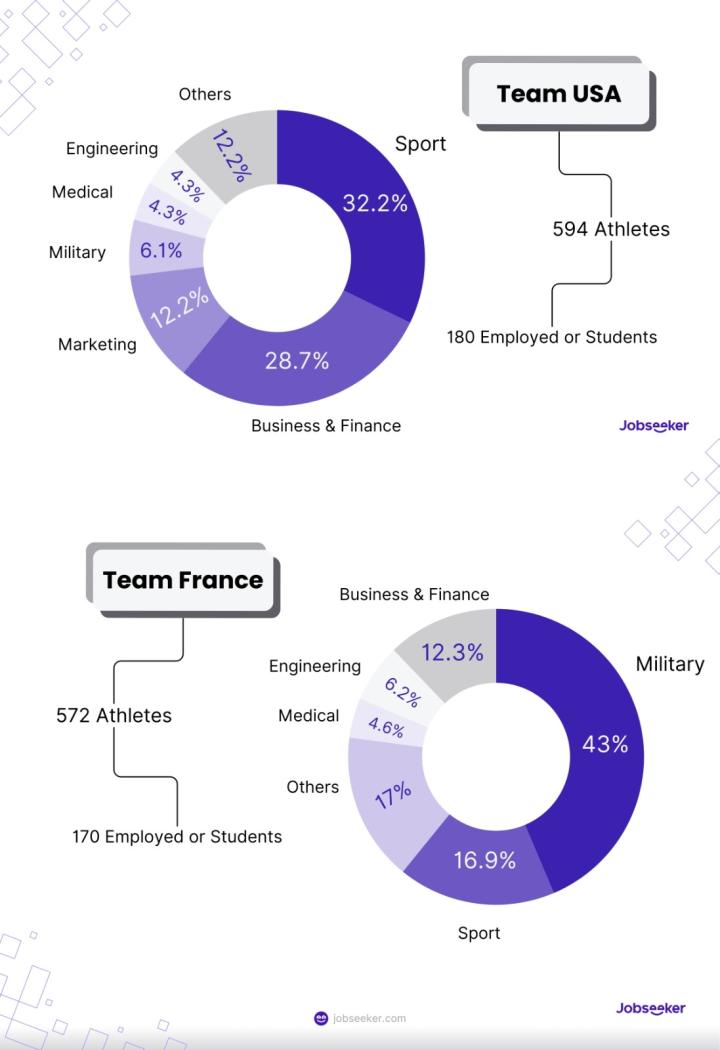
USA's College Sports Programs
- Student-athletes: As the US has a highly developed college sports program, 36% of its athletes with second occupations are students.
- Elite training: The world-class facilities, coaching, and funding of US college sports programs attract and support elite athletes.
France's Military Connections
- Military employment: 30% of French athletes with other occupations work in the military or law enforcement.
- Support programs: This is due to a special program by the French Ministry of the Armed Forces that supports top-level athletes with stable jobs while allowing them to train.
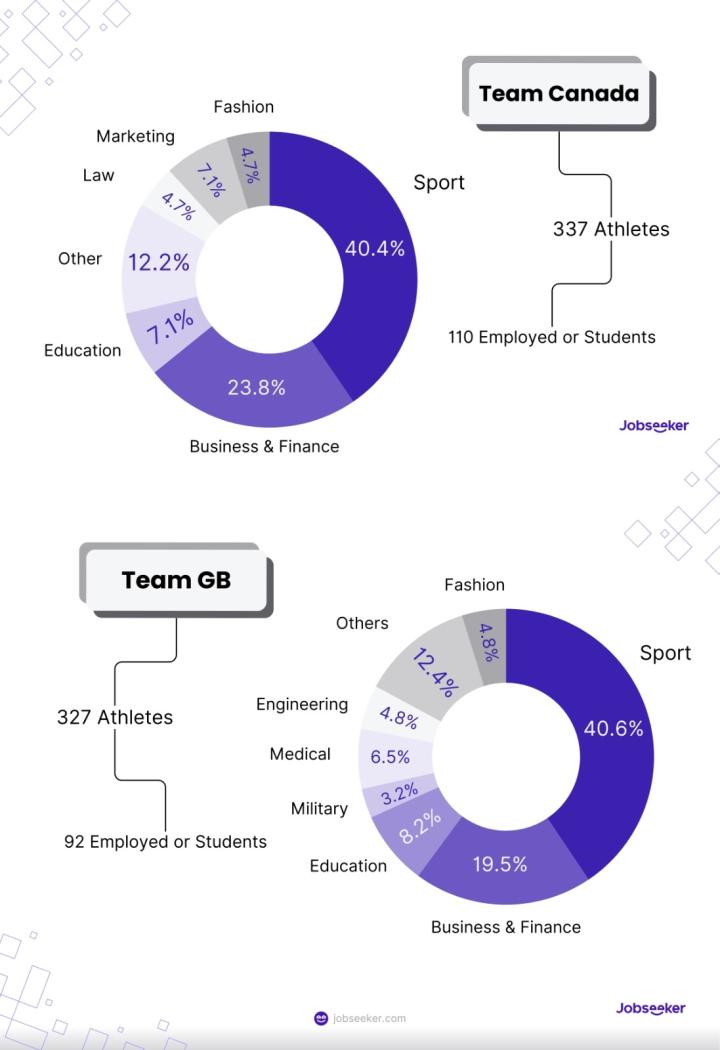
Great Britain's Sports Industry Employment
- Sports sector: 27% of GB athletes with other jobs work within the sports sector.
- Funding model: GB Sport’s funding model supports athletes financially, creating more opportunities within the sports industry.
Canada's Educational Support
- Canadian students: 52% of Canadian athletes with other jobs are students, the highest among the studied countries.
- Cross-border education: Many Canadian athletes benefit from US college sports programs, seeking the best-funded programs and elite coaching available.
These national differences highlight how varying support systems, funding models, and educational opportunities influence the career paths of Olympic athletes. Each country's unique approach shapes the balance between athletic commitments and additional occupations for their athletes.
Gender Imbalance in Athletes’ Secondary Jobs
It’s important to note that 2024 was the first Olympics in history with equal numbers of male and female athletes. Gender parity has been one of the major triumphs of the Paris Olympics. But is this growing equality reflected in the gender split of athletes with jobs?
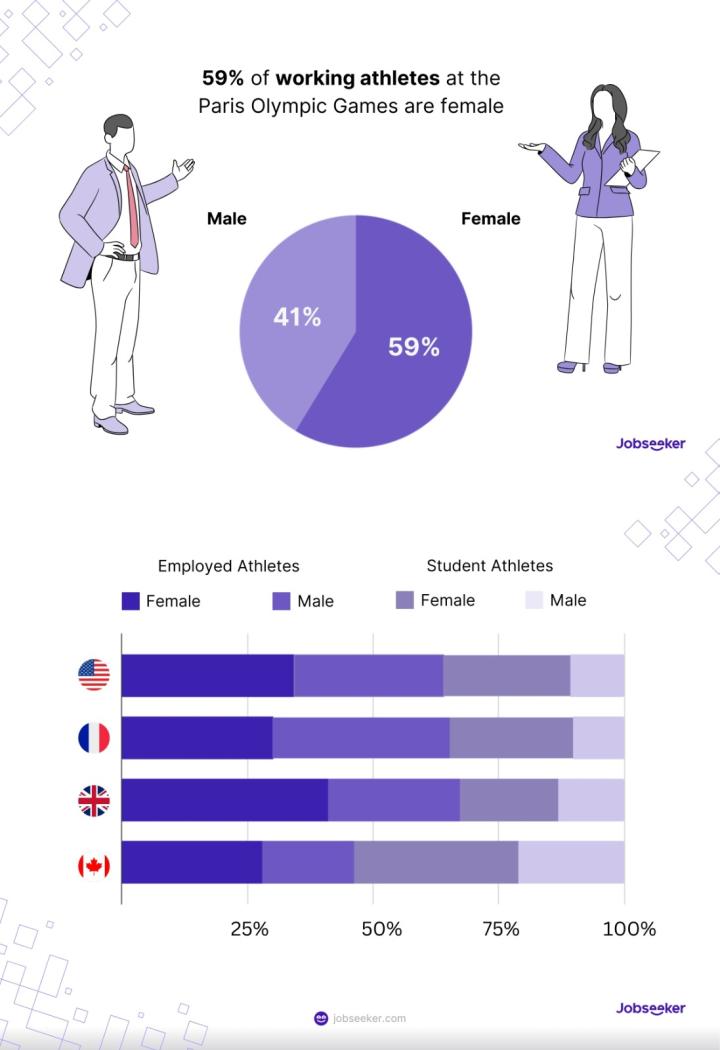
Overall, 59% of working athletes at the Games are female. Let’s take a look at the gender differences in more detail:
- Gender balance in North America: Both Canada and the USA achieved broad equality between the employment of males and females:
- Canada has the most female-dominated team, with 61% of its athletes being female. This could reflect the sports Canada excels in or broader societal trends toward gender equality in sports.
- The US and Canada show an almost equal split in secondary job commitments among male and female athletes. In the US, 20% of female athletes have a job, compared to 19% of males. In Canada, it's 16% for both genders. This balance indicates more equitable support and opportunities for female athletes in these countries.
- European differences: In European countries that we studied, the situation is more varied:
- France: More male athletes work second jobs compared to females (21% vs 18%). This may be due to cultural differences or varying levels of support for female athletes.
- GB: A more pronounced gender split exists, with 22% of female athletes working additional jobs compared to only 15% of males. This disparity suggests potential gaps in funding and support for female athletes in Great Britain.
- Funding and sponsorship: Male athletes tend to receive more income through sponsorship than female athletes. This can reduce the necessity for secondary employment. According to a study by The Women's Sports Foundation, female athletes receive less media coverage and fewer sponsorship opportunities, impacting their earnings and financial stability.
- Cultural factors: Cultural attitudes towards gender roles can influence the availability and types of secondary employment for female athletes. Countries with progressive gender policies and strong support systems for women in sports, such as Canada, tend to show more balanced employment figures.
- Historical context: Historically, female athletes have faced more significant challenges in securing financial support and professional opportunities. While strides have been made, these historical imbalances continue to impact current employment trends.
These insights reveal that while progress has been made towards gender equality in sports, disparities still exist. The differences can be reflective of wider societal factors, or access to opportunities and funding within the sports sector itself. The balance of secondary job commitments among athletes highlights ongoing challenges in achieving full gender parity for female athletes.
Key Points: Olympians & Occupations
If anything, these findings give us even more reason to be in awe of our Olympic heroes. So many of the dedicated and elite competitors at this summer’s Games balance their sporting life with work commitments. This juggling act is more common than many realize, showing the financial and personal sacrifices athletes often have to make.
- 27% of Olympic athletes have additional work commitments.
- A significant number of athletes are students, especially in North America.
- Jobs within the sports industry, business and finance, and the military are common among working athletes.
- National programs, like France's military support and Great Britain's sports funding, play a crucial role in athletes' career paths.
- Gender disparities in employment highlight ongoing challenges in achieving equitable support for female athletes.
These insights can only deepen our admiration for our Olympic heroes. Their commitment often extends far beyond their athletic achievements. Whether supported by national programs or driven by personal necessity, their dedication can be an inspiration to us all.
Methodology
Data was collected from 1,807 athletes competing in the 2024 Paris Olympic Games from four countries: the USA, France, Great Britain, and Canada. The USA and France were selected due to their high number of Olympic athletes, while Canada and Great Britain provided a comparative perspective within North America and Europe. The data points collected included age, gender, country, sport, job, and career category.
A comprehensive database was created to organize and analyze the data, ensuring each athlete's information was recorded in detail. The analysis focused on key comparisons to provide insights into athletes' demographics and career statuses across different countries. This included examining the prevalence of secondary occupations, types of jobs held, national differences, and gender imbalances.
Limitations
While the study provided valuable insights into the occupational statuses of Olympic athletes, several limitations should be noted:
- Data Completeness: The study relied solely on publicly available information on the Official Olympics Website. Athletes who did not disclose their job information were counted as working solely as “athletes,” which may not accurately reflect their actual employment status.
- Representation: The study focused on athletes from only four countries, which may not represent global trends. Other countries' athletes might have different occupational patterns and support systems.
- Temporal Relevance: The data reflects the occupational status of athletes leading up to the 2024 Olympics. Changes in employment status or new support programs implemented after data collection are not accounted for.
- Privacy Constraints: Due to privacy concerns, detailed personal information was not collected, which limits the ability to perform more nuanced demographic analyses.
Despite these limitations, the study offers a meaningful overview of the occupational landscape for athletes at the 2024 Olympic Games, highlighting the challenges and commitments faced by these elite competitors.
Sources:
- Official Olympics Website
- Women's Sports Foundation (2020). Chasing Equity: The Triumphs, Challenges, and Opportunities in Sports for Girls and Women.
- Canadian Women & Sport(2020). The Rally Report: Encouraging Action to Improve Sport for Women and Girls.
Impress potential employers with your resume
Follow step-by-step professional guidance to create a polished resume in minutes.

